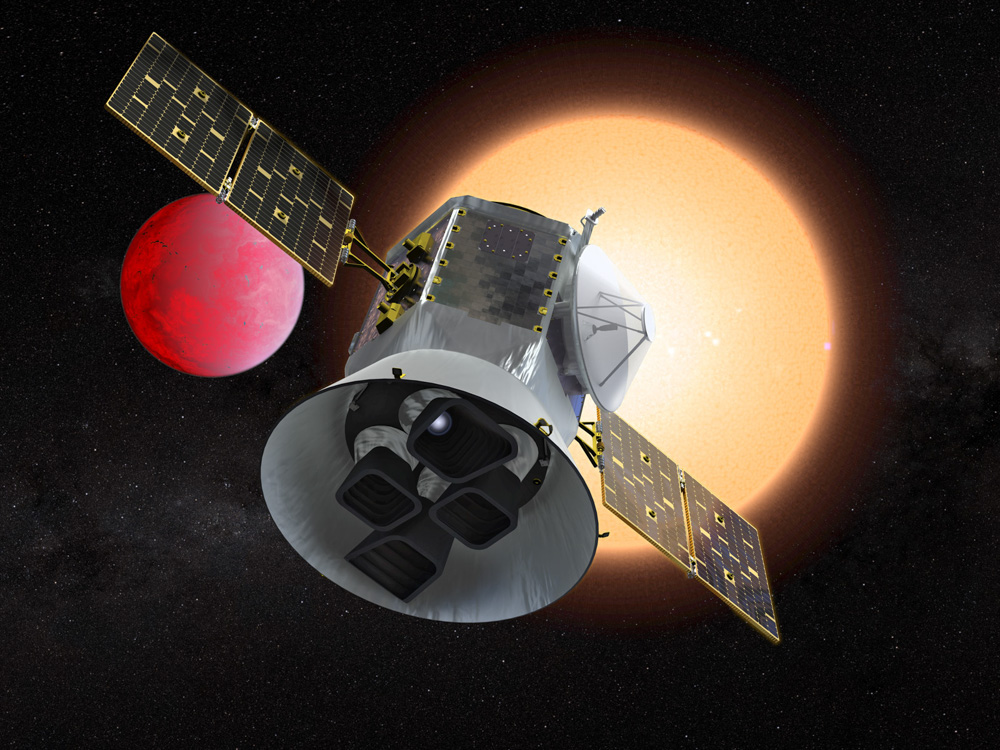The Transiting Exoplanet Survey Satellite (TESS) is a NASA-sponsored Astrophysics Explorer-class mission that will perform an all-sky survey to search for planets transiting nearby stars. The primary goal of TESS is to discover planets smaller than Neptune that transit stars bright enough to enable follow-up spectroscopic observations that can provide planet masses and atmospheric compositions.
Overview
TESS is scheduled to launch no earlier than March 2018 and will be placed in a highly-elliptical 13.7 day orbit around the Earth. In its 2-year prime mission, TESS will monitor about 200,000 main-sequence dwarf stars with four wide-field optical CCD cameras to detect periodic drops in brightness caused by planetary transits. Photometry of these pre-selected targets will be recorded every 2 minutes. TESS will also obtain full-frame images (FFIs) of the entire, four camera field-of-view (24 x 96 degrees) at a cadence of 30 minutes to facilitate additional science.
 The TESS Mission will discovering new Earths and super-Earths in the solar seighborhood. Image Credit: NASA
The TESS Mission will discovering new Earths and super-Earths in the solar seighborhood. Image Credit: NASA
From Kepler to TESS
NASA's Kepler Mission (2009-2013) was a statistical transit survey designed to determine the frequency of Earth-size planets around other stars. Kepler revealed thousands of exoplanets orbiting stars in its 115 square degree field-of view, which covered around 0.25 percent of the sky. While Kepler revolutionized the field of exoplanets and taught us that Earth-to-Neptune-sized planets are common, the bulk of the stars in the Kepler field lie at distances of hundreds to thousands of parsecs, making it difficult to obtain ground-based follow-up observations for many systems.
The TESS Mission is designed to survey over 90% of the sky (an area of sky 400 times larger than covered by Kepler) to search for planets around stars that are nearby (within ~200 parsec). TESS stars will be 30-100 times brighter than those surveyed by the Kepler satellite. Planets detected around these stars will therefore be far easier to characterize with follow-up observations, resulting in refined measurements of the planet masses, sizes, densities, and atmospheric properties.
TESS Guest Investigator Program
The TESS Mission will have a robust Guest Investigator Program (GI program) that will be managed by the TESS Community Science Center at NASA Goddard Space Flight Center. Under the GI program, the astrophysics community may propose new 2 minute cadence targets and investigations using the 30 minute cadence FFI data. TESS GI calls for proposals will occur once per year and be announced within the NASA ROSES solicitation. About 10,000 targets will be available for each GI program cycle.
The TESS mission welcomes proposals including, but not exclusive to, exoplanet, stellar, extragalactic, and solar system science. For specific guidelines on proposing targets through the GI program, visit our Proposal Preparation page.
The following is a list of potential targets:
- Possible transiting planet hosts
- Known exoplanet hosts
- Pulsating stars
- Rotationally variable stars
- Flaring stars
- Accreting stars and interacting binaries
- Binary stars
- Open clusters
- Stellar associations
- Galaxies and supernovae
- Active galactic nuclei
- Microlenses
- Solar System planets
- Asteroids
- Comets